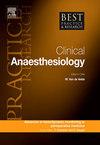Cardiac prehabilitation: Is there a role in cardiac surgery
IF 2.8
3区 医学
Q1 ANESTHESIOLOGY
Best Practice & Research-Clinical Anaesthesiology
Pub Date : 2025-06-01
DOI:10.1016/j.bpa.2025.08.008
引用次数: 0
Abstract
Background
Cardiac surgery presents significant perioperative risks, particularly for high-risk populations such as elderly and frail patients. Prehabilitation, a preoperative strategy focusing on patient optimization, has emerged as a promising intervention to enhance recovery and reduce complications.
Objectives
This review explores the evidence supporting prehabilitation programs, which integrate exercise, nutritional optimization, psychological support, and patient education to improve cardiac surgical outcomes.
Methods
A review of current literature highlights the benefits, challenges, and emerging multidisciplinary approaches in cardiac prehabilitation, including inspiratory muscle training and tailored nutritional support.
Results
While prehabilitation is well-established in other surgical specialties, its implementation in cardiac surgery remains limited due to protocol heterogeneity, time constraints, and patient-specific factors. Early data suggest improved recovery, reduced hospital stays, and better perioperative outcomes.
Conclusions
Standardized prehabilitation protocols and additional research are necessary to improve patient selection, increase adherence, and assess long-term effects. With around one million cardiac surgeries conducted worldwide annually, incorporating structured prehabilitation programs may enhance patient outcomes and refine perioperative care.
心脏康复:在心脏外科手术中有作用吗
背景:心脏手术存在明显的围手术期风险,特别是对老年人和体弱患者等高危人群。预康复是一种术前策略,侧重于患者优化,已成为一种有希望的干预措施,以提高恢复和减少并发症。目的本综述探讨了支持康复计划的证据,包括运动、营养优化、心理支持和患者教育,以改善心脏手术结果。方法回顾当前文献,强调心脏康复的益处、挑战和新兴的多学科方法,包括吸气肌训练和量身定制的营养支持。结果虽然康复治疗在其他外科专科已经很成熟,但由于治疗方案的异质性、时间限制和患者特异性因素,其在心脏外科的实施仍然有限。早期数据表明,恢复改善,住院时间缩短,围手术期预后更好。结论标准化的康复方案和进一步的研究对于改善患者选择、提高依从性和评估长期效果是必要的。全球每年约有100万例心脏手术,结合结构化的康复计划可以提高患者的预后并改善围手术期护理。
本文章由计算机程序翻译,如有差异,请以英文原文为准。
求助全文
约1分钟内获得全文
求助全文
来源期刊

Best Practice & Research-Clinical Anaesthesiology
ANESTHESIOLOGY-
自引率
0.00%
发文量
37
审稿时长
36 days
 求助内容:
求助内容: 应助结果提醒方式:
应助结果提醒方式:


